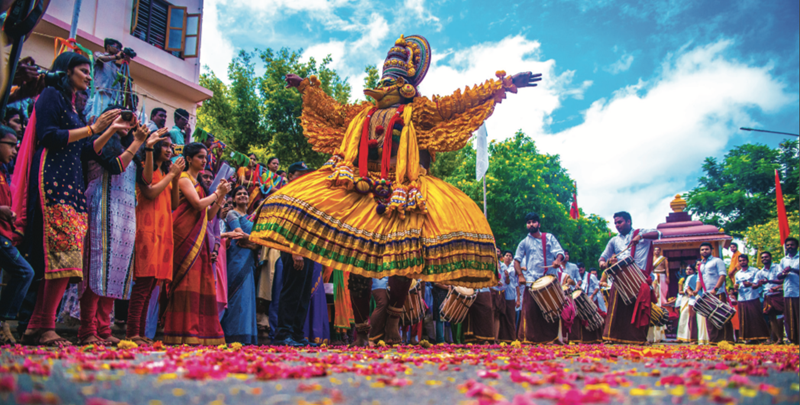Festivals are optimistic and happy occasions of pure outward-bound movements. The mood and noise around give an impression that every single soul is celebrating. However, the question is worth asking: do festivals discriminate?
SAJI P MATHEW OFM
Social capital is the bond of positive engagements and relationships among people
in a group. It promotes trust and cooperation among persons in communities and also in a wider society. Portes A in his essay, Social capital: Its origins and applications in modern sociology, clarifies that economic capital is in people’s bank accounts and human capital is inside their heads, social capital inheres in the structure of their relationships. To possess social capital, a person must be related to others, and it is others, not himself, who are the actual source of his or her advantage.
In a society, examples of social capital is when someone opens a door for someone in need, returns a lost item to a stranger without a second thought, gives someone directions, loans something without a contract, and any such beneficial interaction between people, even if they don’t know each other. It has been shown to be of great importance for societal well-being. Social capital, which is the internal social and cultural coherence of society, is important because it is an important source of power and influence that helps people to go ahead. Studies have found that levels of social capital are related to levels
of academic performance, individual physical health. Greater levels of social capital correspond to lower crime rates in the community.
Festivals are sources of social capital. More inclusive a festival is, greater the level of social capital. Festivals provide space for bonding and bridging, which are articulations of social capital. Bonding refers to social capital created within a group with shared interests and goals. Bridging, on the other hand, is the creation of social capital across groups. Festivals, being
a time of sharing, caring, and giving, nurture social ties and participation.
Festivals play a key social role in all societies and cultures. Communities must be given the opportunity to celebrate. There is a coming together of synergy in celebrating festivals with cultural symbols, entertainment, and community gatherings in public spaces. It enhances the shared life of the community.
Political Economy and
Caste Prejudices of Festivals
Festivals in India are colourful. October and November months have the maximum pan-India festivals. The country is in a celebration temper. Its individuality and uniqueness comes from its multiple cultural and religious facets and deep rooted belief in pluralism. India is home to every major religion and every way of life in the world. As Indians solidify their religious establishments and embraced other religions of the world, the inter-sectionality of the already stratified Indian society poses a serious challenge.
Festivals generate openings and opportunities, especially for small to medium businesses. Communities value festivals and special events because they not only enhance the community image but also provide activities and spending outlets for hosts and visitors. This festival sea- son, starting from October has done the honors to boost up our pandemic hit economy. Business Standard observes that during major festivals like Diwali, Navratri, Eid, etc, there is a significant rise in demand for various products and services. Businesses in India, particularly small businesses, have faced significant obstacles in these years due to the unprecedented outbreak of Covid-19. Thanks to multiple festivals in recent times, they have given hope for recovery for our struggling economy. Small businesses are critical to our society’s economic and social fabric, and in celebrating our festivals we all play a part in their survival.
Political parties compete to usurp and
use festivals as tools for political and social mobilization. From Shabrimala, down south, to Durga Puja in the North East are all examples. In recent times in Tamil Nadu, in the pretext of offering prayers in Murugan temple, the BJP leaders took on a Vel (symbol of Lord Muruga) yathra in an attempt to identify with the masses in Tamil Nadu.
Festivals have social and psychological objectives. They are cathartic. Festivals are creative spaces for multiple expressions and reflections. It is a process in which people, even from the lower classes and castes, could release pent-up frustrations and emotions. Thus we see through dances and violent movements people relive history and traditions during festivals. Some festivals are accompanied by rituals and customs, for example, Theyyam of north Kerala,
brings to life the great stories of heroes and spirits of their ancestors. Some festivals are part of a peoples’ resistance against upper cast hegemony. Balmurli Natrajan in his research titled, Cultural identity and beef festivals: toward a multiculturalism against caste, establishes that Dalits have been at the forefront of organizing beef festivals as counter-hegemonic discourse.
Across religions, festivals have been discriminatory on various lines, especially on one’s caste. One of the loud and well-participated festivals of India is the Ganesh festival. But it is sad to see that different castes have their own Ganesh pandals. I have read an interesting story about the origin of the immersion of the Ganesh idol in water. It was Tilak who started the practice of building open public pandals to keep the Ganesh idol, and people of all castes had access to it. On one such occasion a Dalit came forward to touch the idol, leading to a large hue and cry among the upper caste Hindus. They were unhappy about disturbing the purity and sanctity of the Hindu social norms. Thus the smart ones among them handled the conflict by introducing the ritual of immersing the idol in water at the end of the festival. Thus the idol, soiled by the touch of the lower castes, is purified.
Festivals of course are sources of social capital; but our festivals are yet to become nondiscriminatory sources of social capital irrespective of our castes, colour, and class.
∎